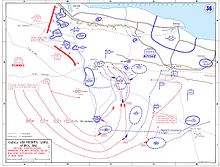Battle at Bir el Harmat
Coordinates: 31 ° 37 ′ 0 ″ N , 23 ° 28 ′ 0 ″ E
The battle at Bir el Harmat is also known as the Battle Without a Name and took place from June 2 to 11, 1942 in the Libyan desert between Jewish volunteers from the British 8th Army and the German Africa Corps , the German Air Force and the Italian Army . Like the battle of Bir Hakeim, which took place not far from the same time, it was a successful defensive battle between the Allies in the African campaign .
Starting position
Bir el Harmat was in the area of the Gazala Line, which had been reinforced by the Allies with a series of strongly fortified defensive positions (so-called boxes) to ward off an enemy advance. The place itself was about twelve kilometers north of the Bir Hakeim oasis held by the French , the Jewish position was about halfway between Bir el Harmat and Bir Hakeim. The approximately 400 Jewish soldiers ( Zionist volunteers from Palestine ) under the command of Major Felix Liebmann had been doing mine-laying work there since May 1941 and were therefore only lightly armed. On May 26, 1942, Colonel-General Erwin Rommel started the Theseus companies in the Kyrenaica with the aim of conquering Tobruk and El Alamein and thus giving the war in North Africa a decisive turn for the Axis powers .
course
On June 2, 1942, a German tank column appeared in front of Bir el Harmat and called on the defenders to surrender . Liebmann refused, and a few hours later bombed German Ju 87 - dive bomber Jewish positions. Since Liebmann had no anti-aircraft guns available, his men suffered severe failures . Until June 4, the Fiat M13 / 40 tanks of the Italian Ariete division were constantly attacking . Some of them remained in the minefields , but ultimately managed to break into the center of the Jewish position. Since there were no anti-tank weapons either, they had to be eliminated with Molotov cocktails .
The radio contact to the command of the British 8th Army broke off, and the axis forces continued their tank attacks on 5 and. June 6th away. These also remained unsuccessful, as the defenders had now dug themselves in even more firmly. From June 7th, the attackers tried to break the resistance with artillery fire and further air strikes , but the Jewish soldiers fought doggedly and did not give up despite the lack of water. Only after the British High Command had ordered the evacuation of the position on June 10, the defenders withdrew on the night of the following day and joined the British and Free French allies at Qasr el Abid . They had lost three quarters of their people.
The French Brigadier General Kœnig only now learned from Liebmann that an Allied unit in the immediate vicinity had suffered the same fate as the soldiers of his brigade at Bir Hakeim, but did not know about their nationality. When Liebmann told him that they were Jews from Palestine and were not allowed to fight under their own flag due to British directives , the general ordered him to hoist it anyway and offered her the military salute .
consequences
Rommel had wasted valuable time here so that the Allies could order their retreat. Nevertheless Tobruk was lost, but at El Alamein his advance could be stopped. Rommel's last attempt to end the war in North Africa for the Axis Powers had failed, not least because of the determined resistance of some Free French and Jewish volunteers.
In the skirmish, Jewish soldiers also passed their first baptism of fire against a regular army, after they had previously proven themselves in guerrilla warfare or in combat support. This not only spurred the creation of an independent Jewish brigade in the British Army , but also had great symbolic power for the Zionist movement.
literature
- François Milles: Premiér Revanche - Rommel: “Des juifs dans le Désert” , in Les combats d'Israël , p. 22ff, edited by Joseph Kessel (published in the Combats de l'Histoire series No. 275 ), Tallandier, Paris 1973
- François Milles: Jews from Palestine in the desert war near Bir Hakeim , in Arno Lustiger , For the struggle for life and death! On the resistance of the Jews in Europe 1933–1945 , Kiepenheuer & Witsch, Cologne 1994, (licensed edition Erftstadt 2005) p. 546ff

